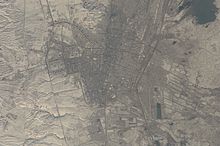
A | B | C | D | E | F | G | H | CH | I | J | K | L | M | N | O | P | Q | R | S | T | U | V | W | X | Y | Z | 0 | 1 | 2 | 3 | 4 | 5 | 6 | 7 | 8 | 9
Ashgabat
Aşgabat | |
|---|---|
Neutrality Road, Gypjak Mosque, Abadanchylyk Square, Independence Park, Suburbs, Urban highways | |
 | |
| Coordinates: 37°56′15″N 58°22′48″E / 37.93750°N 58.38000°E | |
| Country | |
| Founded | 1881 |
| Government | |
| • Type | Presidential[1] |
| • Mayor | Rahym Nurgeldiyewic Gandymow (since 9 June 2021) [2] |
| Area | |
| • Total | 470 km2 (180 sq mi) |
| Elevation | 273 m (896 ft) |
| Population (2022 census)[3] | |
| • Total | 1,030,063 |
| • Density | 2,200/km2 (5,700/sq mi) |
| Time zone | UTC+05:00 |
| • Summer (DST) | UTC+05:00 (not observed) |
| Postal code | 744000–744040 |
| Area code | (+993) 12 |
| Vehicle registration | AG |
| Website | ashgabat.gov.tm |

Ashgabat, also spelled Asgabat (/ˌɑːʃɡəˈbɑːt/ or /ˈɑːʃɡəbæt/;[4] Turkmen: Aşgabat, [ɑʃɢɑˈbɑt];[5] Persian: عشقآباد, romanized: Ešqābād), formerly named Poltoratsk (Russian: Полтора́цк, IPA: [pəltɐˈratsk]) between 1919 and 1927, is the capital and the largest city of Turkmenistan. It lies between the Karakum Desert and the Kopetdag mountain range in Central Asia, approximately 50 km (30 mi) away from the Iran-Turkmenistan border. The city has a population of 1,030,063 (2022 census).
The city was founded in 1881 on the basis of an Ahal Teke tribal village, and made the capital of the Turkmen Soviet Socialist Republic in 1924. Much of the city was destroyed by the 1948 Ashgabat earthquake, but has since been extensively rebuilt under the rule of Saparmurat Niyazov's "White City" urban renewal project,[6] resulting in monumental projects sheathed in costly white marble.[7] The Soviet-era Karakum Canal runs through the city, carrying waters from the Amu Darya from east to west.[8] Since 2019, the city has been recognized as having one of the highest costs of living in the world largely due to Turkmenistan's inflation and import issues.[9][10][11]
Etymology

Ashgabat is called Aşgabat in Turkmen, (Russian: Ашхабад, romanized: Ashkhabad) in Russian from 1925 to 1991, and عشقآباد ('Ešqābād) in Persian. Before 1991, the name was usually spelled Ashkhabad in English, a transliteration of the Russian form. It has also been variously spelled Ashkhabat and Ashgabad. From 1919 until 1927, the city was renamed Poltoratsk after a local revolutionary, Pavel Poltoratskiy.[12]
Although the name literally means "city of love" or "city of devotion" in modern Persian, the name might be modified through folk etymology. Turkmen historian Ovez Gundogdiyev believes that the name goes back to the Parthian era, 3rd century BC, deriving from the name of the founder of the Parthian Empire, Arsaces I of Parthia, in Persian Ashk-Abad (the city of Ashk/Arsaces).[13]
Geography
Ashgabat is in near proximity, approximately 50 km (30 mi), to the Iranian border.[14] It occupies a highly seismically active oasis plain bounded on the south by the foothills of the Kopet Dag mountains (Turkmen: Köpetdag) and on the north by the Karakum Desert. It is surrounded by, but not part of, Ahal Province (Turkmen: Ahal welaýaty). The highest point in the city is the 401 metres (1,316 ft) high sandhill upon which the Yyldyz Hotel was built, but most of the city lies between 200 and 255 metres (656 and 837 ft) of elevation. The Karakum Canal runs through the city.[15][16][17]
Like the rest of Turkmenistan, Ashgabat's soil is primarily sediment that accumulated on the bottom of the Paratethys Ocean. The Kopet Dag mountains emerged toward the end of the Cretaceous Period.[18]
Urban layout
1881 to 1929
Prior to 1881 any buildings other than yurts were made solely from adobe and were limited to one story in height due to the seismic risk.[19] As of 1900 only one building in the city was two stories tall, the municipal museum.[20] City planning began following the Russian conquest, with "very simple planning schemes". The basic layout of downtown streets "has been preserved to this day and defined the unique character of the city structure combining linear and radial types of layout of blocks". The Russian writer Vasily Yan, who lived in Askhabad from 1901 to 1904, described the city as "a little tidy town consisting of numerous clay houses, surrounded by fruit gardens with straight streets, planted with slim cottonwood, chestnut, and white acacia planned by the hand of military engineers".[21] Another description noted,
- The fortress was the center of the bureaucratic part of the city. Here stood especially sturdy thick-walled houses, with strong window grates and corner buttresses. Earthquakes were less frightening in such houses, and behind the thick walls even in the hottest months some measure of indoor coolness was retained. Each house had a garden around it, on maintenance of which residents spared neither expenditures nor water...Nearer the rail station lived the railroad workers and craftsmen. Here the houses were shorter and more densely spaced, gardens smaller, and dust on the streets greater...
- Gradually a third center of Ashkhabad started to emerge, of the merchants. Roughly equidistant from the rail station and the fortress was laid out a sad marketplace, becoming not only a center of stores and stalls, but a center of gravity for merchants' residence.[22]
1930 to 1948
In 1930, asphalt was used for the first time to pave Ashgabat's streets.[23] The water supply was increased by piping water from springs in neighboring Gämi and Bagyr.[23]
The first master plan for Ashgabat, developed between 1935 and 1937 at the Moscow Institute of Geodesy, Aerial Imagery, and Cartography, envisioned expansion to the west, including irrigation and greening of the Bikrova canyon (today Bekrewe).[17] The city architect's office was created in 1936 but was unable to implement the new master plan "as it implied significant demolition of the existing buildings".[24] A description of Ashgabat published in 1948 just before the earthquake noted, "In Ashgabat there are nearly no tall buildings, thus every two-story building is visible from above...", i.e., from the foothills. The tallest structures were the clock tower of the textile mill, the "round smokestack of the glass factory", two "exceptionally thin minarets" of the "former mosque", and "two splendid towers over the long building of the main city hotel".[22]
Impact of the 1948 earthquake

During the 1948 earthquake, since the bulk of Ashgabat at that time was built of either adobe or fired brick, all but a very few buildings collapsed or were damaged beyond repair (the reinforced concrete grain elevator, Church of St. Alexander Nevsky, and Kärz Bank were among the structures that survived).[25][26] According to Turkmenistan's official news agency,
- Nearly all one-story residential buildings in the city made of mud brick were destroyed, 95 percent of all one-story buildings made of fired brick, and the remaining structures were damaged beyond repair. The number of inhabitable buildings was in single digits, and at that, only after capital renovation.[24]
A new general plan was hastily developed by July 1949. The city was divided into four zones: central, northern, eastern, and southwestern. Reconstruction of the city began in that year.[17][24] Thus from the early 1950s through 1991 Ashgabat's skyline was dominated by the Brutalist Style favored by post-Stalin Soviet architects.[27] The city's central avenue, Magtymguly (former Kuropatkin, Freedom, and Stalin Prospect), featured "monotonous and primarily two-story construction of administrative and residential buildings". This reconstruction "preserved the existing network of city streets as it was economically unjustified to redesign them".[24] The city was described as "...a Communist-era backwater, rebuilt into a typically drab provincial Soviet city..."[28] The plan was updated in 1959.[29]
Among the buildings erected in the 1950s and 1960s were the headquarters of the Central Committee of the Turkmenistan Communist Party, the Council of Ministers Building, the Mollanepes Academic Drama Theater, the former Ashkhabad Hotel (now renamed Paytagt), the Academy of Sciences complex, and the downtown library building. On then-Karl Marx Square stood a monument to the Soviet "fighters for victory of Soviet power in Turkmenistan".[17]
The 1960s master plan
The Turkmen State Project Institute undertook a feasibility study in the mid-1960s to forecast Ashgabat's development to the year 2000, and on that basis to develop a new master plan. Up until then the city had largely expanded to the east, but now the plan called for development to the south and west. This plan was used for about 20 years, and led to construction of the city's first four-story apartment buildings in the Howdan (Russian: Гаудан) microdistricts, formerly the site of the Ashgabat-South aerodrome, as well as annexation of three collective farms in the near suburbs and their conversion into residential neighborhoods, one of which, Leningrad kolkhoz, to this day is referred to informally by its former name.[24][30] The plan was reworked in 1974, and this resulted in relocation of several industrial plants away from the city center, and thus creation of the industrial zones to the northwest, south, southeast, and northeast.[17]
Between 1961 and 1987 the city architect was Abdulla Ahmedov, who introduced Soviet modernism to Ashgabat.[31] Ahmedov's greatest architectural accomplishment during this period is considered the Ashgabat Hotel (today renamed Paytagt Hotel), built between 1964 and 1970, "a harmonious synthesis of architecture and monumental art".[31]
Growth
In 1948 Ashgabat was described before the earthquake as lying "on a sloping plain of the Kopet-Dag foothills, stretching seven kilometers from west to east and five kilometers from the railroad right-of-way to the south, in the direction of the mountains".[22] Through the mid-1970s, Ashgabat was a compact city, as shown by the 1974 Soviet military's General Staff map J-40-081.[32] The village of Köşi, collective farm "Leningrad", airport, and suburbs to the north were outside the city limits.
Beginning in the 1970s, Ashgabat's boundaries shifted outward, with the aforementioned municipalities annexed, the aerodrome at Howdan redeveloped, and creation of the Parahat (Russian: Mir) neighborhoods to the south and industrial parks to the east. In 2013, Ashgabat annexed a portion of the then-Ruhabat district of Ahal Province as well as the city of Abadan (previously named Büzmeýin, and renamed that as a neighborhood) plus all land and villages in between. The southern boundary of Ashgabat was extended southward to the foothills of the Kopet Dag mountains. Overall, Ashgabat's land area rose by 37,654 hectares. The following municipalities were abolished due to their incorporation into the city of Ashgabat: city of Abadan, towns of Jülge and Ruhabat, villages of Gökje, Gypjak, Birleşik, Magaryf, Herrikgala, Ýalkym, Gurtly, Hellewler, Ylmy-Tejribe bazasy, Ýasmansalyk, Köne Gurtly, Gulantäzekli, Serdar ýoly, Gaňtar, Gyzyljagala, Inerçýage, Tarhan, Topurly, and Ussagulla.[33][34][35] A further expansion occurred January 5, 2018, when additional land to the north was annexed, incorporating the Gurtly Reservoir and two greenfield residential construction projects, known today as Täze Zaman. This statute also established the current four boroughs of Ashgabat.[36][37]







